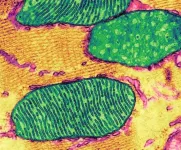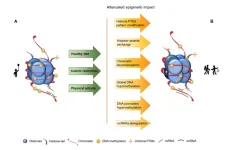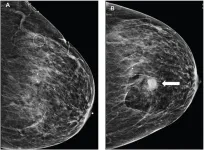(Press-News.org) Colorectal cancer is the fourth most common and second deadliest cancer. How colorectal cancer develops is not well understood, but a team led by researchers at Baylor College of Medicine reports in the Journal of Experimental & Clinical Cancer Research that silencing the gene p16, even though the DNA itself does not change, can drive colorectal cancer progression in animal models. The researchers also revealed a strategy that reduced tumor growth and improved survival in tumor-bearing mice, opening new possibilities for future targeted therapies in patients with gene p16 alterations.
“Years of research have shown that human colorectal cancer occurs in steps,” said corresponding author Dr. Lanlan Shen, professor of pediatrics - nutrition and member of the Dan L Duncan Comprehensive Cancer Center at Baylor. “First, a gene mutates leading to the formation of benign polyps, small clumps of cells that grow in the lining of the colon. Then, changes in a second gene drive the benign polyps to become malignant or cancerous growth. This process has not been studied well because, until now, we did not have an animal model that recapitulated the human cancer.”
In this study, the Shen lab and colleagues developed the first animal model of colorectal cancer that mimics the developmental process of the human condition. Using this model, the team investigated a particular change in the second gene called p16 and its effect in colorectal cancer growth.
Normally, gene p16 suppresses tumor growth, but as people age, p16 is silenced. Aging is the strongest risk factor for colorectal cancer. Silenced p16 is frequently found in colorectal cancer, which could explain why older people get this type of cancer more than younger people.
In this case, p16 is not silenced by a mutation of the DNA sequence of the gene itself, but by a different process called epimutation. Epimutations are chemical modifications such as attaching or removing a methyl chemical group in a gene. This chemical modification or methylation acts like a switch, turning p16 off when adding a methyl group and turning it on by removing the methyl group. This is important from the therapeutic point of view, because, unlike mutations which are difficult to reverse, epimutations are intrinsically reversible.
“Our animal model is the first to include both a genetic mutation called Apc that can initiate a benign tumor growth, and an epigenetic change, methylation of gene p16,” Shen said. “We conducted long-term survival and microscopy analysis of tumor development and progression and found that mice carrying combined Apc mutation and p16 epimutation had significantly shortened survival and increased tumor growth compared to those with Apc mutation only.”
Interestingly, colorectal tumors with the gene p16 turned off were growing in a microenvironment that suppressed the immune response against the tumor, favoring cancer growth. These observations prompted the researchers to test a combined treatment for these tumors.
“We combined a drug that inhibits DNA methylation of gene p16, turning it on, with another drug that removes the suppression on the immune response, allowing it to attack the tumor,” Shen said. “The combined drug treatment was more effective for improving survival in tumor-bearing mice than each drug alone.”
Research has shown that human colorectal cancers have many DNA methylation alterations, but the contributions of these modifications to tumor initiation and maintenance remain an important unmet need.
“We seek to better understand the mechanisms by which epimutations frequently observed in cancer cells contribute to cancer development and progression,” Shen said. “Our animal model is a valuable laboratory tool to study these mechanisms and also to screen potential treatments that could later be developed as therapies for patients.”
Other contributors to this work include Li Yang, Xiaomin Chen, Christy Lee, Jiejun Shi, Emily B. Lawrence, Lanjing Zhang, Yumei Li, Nan Gao, Sung Yun Jung, Chad J. Creighton, Jingyi Jessica Li, Ya Cui, Sumimasa Arimura, Yunping Lei and Wei Li. The authors are affiliated with one or more of the following institutions: Baylor College of Medicine, University of California-Los Angeles, University of California-Irvine, Princeton Medical Center and Rutgers University.
This research was supported by grants from U.S. Department of Agriculture (CRIS 3092-51000-060) and National Institutes of Health (R21CA229727, R01HD100914, and R01CA233472).
END
Gene p16 drives colorectal cancer emerging as a target for potential therapies
2023-05-10
ELSE PRESS RELEASES FROM THIS DATE:
New database offers insight into consequences of language loss
2023-05-10
New database offers insight into consequences of language loss
Languages, like animal species, can go extinct. More than half of the world’s approximately 7,000 signed and spoken languages are currently endangered. And without intervention they are likely to become extinct, meaning nobody will speak or sign them any longer.
While language loss is happening across the world, the costs vary strikingly in different places, according to a new study co-authored by Yale linguist Claire Bowern. Regions where all Indigenous language are endangered — including parts of South America and the United States — ...
Bigger isn’t always better: Size of research teams does not equate to better research outcomes, finds new study
2023-05-10
Having a large research team isn’t linked to producing higher quality research, finds a new study from the University of Surrey which analysed data from 1.4 million academic papers.
Professor Sorin Krammer, lead author of the study and Professor of Strategy and International Business at the University of Surrey, said:
“Despite the prevalence of large teams in research, there is still a lack of a good understanding of how their size and diversity affects their performance.”
“Our ...
The acute problem of chronic disease
2023-05-10
In medicine and science, the term “pathogenesis” describes the origin and development of disease. There is not, however, a broadly accepted term to describe the other half of the equation: the process of healing and recovery.
In a new and far-reaching paper, published May 10, 2023 in the journal Mitochondrion, Robert K. Naviaux, MD, PhD, professor of Medicine, Pediatrics and Pathology at UC San Diego School of Medicine, proposes both a term and, more importantly, outlines the array of processes and players, beginning with cellular mitochondria, that drive the healing process – and whose dysfunction underlies chronic illnesses from diabetes ...
An epigenetic approach to modulating aging with nutrition and exercise
2023-05-10
“In this review, we describe how aging impacts epigenetics and how nutrition and physical exercise can positively impact the aging process, from an epigenetic point of view.”
BUFFALO, NY- May 10, 2023 – A new review paper was published in Aging (listed by MEDLINE/PubMed as "Aging (Albany NY)" and "Aging-US" by Web of Science) Volume 15, Issue 8, entitled, “How can we modulate aging through nutrition and physical exercise? An epigenetic approach.”
The World Health Organization predicts that by 2050, 2.1 billion people worldwide ...
APL Photonics selects recipient for 2022 Future Luminary Award
2023-05-10
MELVILLE, N.Y., May 10 – The University of Arizona’s Husain Alqattan is the recipient of the APL Photonics 2022 Future Luminary Award for his work in utilizing pulse shaping and waveform synthesis to control electron motion and open the door for ultrafast electronics that process data at unprecedented speeds.
The winning paper, “Attosecond light field synthesis,” was published in the April 2022 issue of APL Photonics. In it, Alqattan and his team used an attosecond light ...
Using AI to predict important measure of heart performance
2023-05-10
Coronary heart disease is the leading cause of adult death worldwide. The coronary angiography procedure provides the clinical standard diagnostic assessment for nearly all related clinical decision-making, from medications to coronary bypass surgery. In many cases, quantifying left ventricular ejection fraction (LVEF) at the time of coronary angiography is critical to optimize clinical decision-making and treatment decisions, particularly when angiography is performed for potentially life-threatening acute coronary syndromes (ACS).
Since the left ventricle is the heart’s pumping center, measuring the ejection fraction in the chamber provides critical information about the percentage ...
Bleeding after image-guided breast biopsies: Discontinuing vs. maintaining antithrombotic therapy
2023-05-10
Leesburg, VA, May 10, 2023—According to an accepted manuscript published in ARRS’ own American Journal of Roentgenology (AJR), frequencies of imaging-apparent and palpable hematoma were not significantly different between patients temporarily discontinuing versus maintaining antithrombotic therapy (AT).
“The findings support safety of continuing AT during breast core-needle biopsy (CNB),” wrote lead researcher Melissa Reichman, MD, of Weill Cornell Medicine at New York-Presbyterian ...
Ohio State professor elected to National Academy of Sciences
2023-05-10
COLUMBUS, Ohio - An Ohio State University astronomy professor has been elected to the National Academy of Sciences, one of the highest honors a scientist can receive in the U.S.
David Weinberg, Distinguished University Professor and chair of astronomy, is among 120 new members and 23 international members from 13 countries who were inducted this year in recognition of distinguished and continuing achievement in original research inside their chosen field.
“I have been lucky to have great students and great colleagues throughout ...
New Cleveland Clinic research links immune cell receptors to asthma, inflammatory lung disease
2023-05-10
CLEVELAND - Inhibiting a protein on the surface of immune cells could offer new strategies for treating severe asthma, Cleveland Clinic researchers found.
Researchers discovered a new way a protein called MCEMP1 contributes to severe inflammation in the airway and lungs. The discovery, published in Nature Communications, provides critical information for developing therapeutic interventions to treat long-term lung conditions, including asthma, on a biological level.
The study was conducted in a lab led by Jae Jung, PhD, chair ...
Entangled quantum circuits
2023-05-10
A group of researchers led by Andreas Wallraff, Professor of Solid State Physics at ETH Zurich, has performed a loophole-free Bell test to disprove the concept of “local causality” formulated by Albert Einstein in response to quantum mechanics. By showing that quantum mechanical objects that are far apart can be much more strongly correlated with each other than is possible in conventional systems, the researchers have provided further confirmation for quantum mechanics. What’s special about ...




